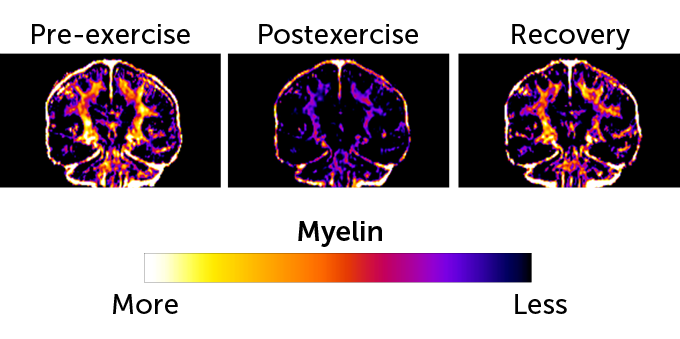Brain tissue may be fuel for marathon runners
A study suggests nerve cell insulation, or myelin, is an energy source during endurance exercise

Long-distance runners may tap into myelin as a fuel source for the brain. The fatty tissue insulates nerve cells and seems to diminish just after a race, then build back up in the following weeks.
Michael Blann/gettyimages
In endurance athletes, some brain power may come from an unexpected source.
Marathon runners appear to rely on myelin, the fatty tissue bundled around nerve fibers, for energy during a race, scientists report October 10 in a paper posted at bioRxiv.org. In the day or two following a marathon, this tissue seems to dwindle drastically, brain scans of runners reveal. Two weeks after the race, the brain fat bounces back to nearly prerace levels. The find suggests that the athletes burn so much energy running that they need to tap into a new fuel supply to keep the brain operating smoothly.
“This is definitely an intriguing observation,” says Mustapha Bouhrara, a neuroimaging scientist at the National Institute on Aging in Baltimore. “It is quite plausible that myelin lipids are used as fuel in extended exercise.”
If what the study authors are seeing is real, he says, the work could have therapeutic implications. Understanding how runners’ myelin recovers so rapidly might offer clues for developing potential treatments — like for people who’ve lost myelin due to aging or neurodegenerative disease.
Much of the human brain contains myelin, tissue that sheathes nerve fibers and acts as an insulator, like rubber coating an electrical wire. That insulation lets electrical messages zip from nerve cell to nerve cell, allowing high-speed communication that’s crucial for brain function.
The fatty tissue seems to be a straightforward material with a straightforward job, but there’s likely more to it than that, says Klaus-Armin Nave, a neurobiologist at the Max Planck Institute for Multidisciplinary Sciences in Göttingen, Germany. “For the longest time, it was thought that myelin sheathes were assembled, inert structures of insulation that don’t change much after they’re made,” he says.
Today, there’s evidence that myelin is a dynamic structure, growing and shrinking in size and abundance depending on cellular conditions. The idea is called myelin plasticity. “It’s hotly researched,” Nave says.
Fatty molecules and other myelin sheath components regularly turn over, breaking down the insulating material and building it back up again, he says. In mice, brain cells can tap into these in-flux fats when sugar — the brain’s typical energy source — is scarce, Nave’s team’s experiments have suggested.
Carlos Matute, a neurobiologist at the Achucarro Basque Center for Neuroscience and the University of the Basque Country in Leioa, Spain, wondered if these fats could also sustain the brains of endurance athletes. He’s a marathon runner and had been curious how people’s brains continued working after strenuous exercise drained energy reserves in the body.
Using an MRI, his team scanned the brains of four marathon runners in the days before and after the race, and two of the runners two weeks later. A day or two after the race, the team saw a reduction in the amount of myelin in the brain. That suggested the myelin wrapped around nerve fibers had thinned, Matute says. After two weeks, much of the myelin had returned, thickening again around neural fibers.

That’s a rapid decline followed by a rapid recovery, says Bouhrara, a drastic result that gives him pause. Matute and colleagues used water trapped between layers of myelin as a proxy for myelin content. More of this water indicates more myelin. But you can’t rule out the effects of dehydration, Bouhrara says. If runners are dehydrated after their race, their brain tissues may just be dried out.
It’s a point Matute has heard before, when presenting his data to colleagues. “In our opinion, this is not the case.” His team scanned the runners days after their race, so they had time to rehydrate, he says. What’s more, the runners’ brain volumes stayed nearly the same before and after the marathon. Dehydrated brains would probably be smaller, Matute says. “We saw that there is no shrinkage of the brain at all.”
Now, his team is following the thread of their findings; they want to see if the runners’ myelin dip alters brain function, and how long it takes to recover completely.
Matute points out that his results don’t mean running is bad for the brain. “Not at all,” he says. It’s possible that using and replenishing energy reserves is beneficial because it exercises the brain’s metabolic machinery.







